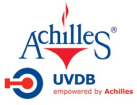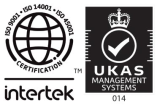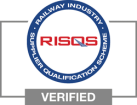-
Lifting Equipment
 Browse Lifting Equipment Shop
Browse Lifting Equipment Shop
- Chain Hoists
-
Wire Rope Hoists
- Hand Operated Wire Rope Winches and Hoists
- Cable Pullers / Hoists, Wire Rope Manual Operation
- Electric Winches and Hoists, AC (Mains Powered)
- Scaffold Hoists & Accessories
- Overhead Wire Rope Crane Hoists
- Hydraulic Wire Rope Winches & Hoists
- Pneumatic Wire Rope Air Winches / Hoists (Lifting and Pulling)
- Vehicle Mounted Winches
- Tractel Wire Rope & Accessories
-
General Lifting Equipment
- Fibre Slings
- Chain Slings Assemblies & Components
- Lifting and Lashing Chain
- Wire Rope Slings & Assemblies
- Shackles
- Eyebolts and Eyenuts
- Lifting & Pulling Clamps
- Lifting Beams & Spreader Beams
- Precast Concrete Lifting
- Lifting Magnets, Permanent, Battery Electric and Manual
- Runway Beam Monorail Crane Trolleys, Push, Geared & Electric
- Equipment Identification Tags
-
Rigging Equipment
- Crosby Lifting & Rigging
- Master Ring & Load Suspension Eyes
- Lifting & Rigging Hooks
- Turnbuckles & Rigging Screws
- Wire Rope Accessories and Fittings
- Snatch Blocks, Sheave Blocks and Crane Pulley Blocks
- Load Restraint Equipment
- General Rigging Accessories
- Lifting & Rigging Swivels - Eye, Hook & Shackle
- Pulley Sheaves
-
Cranes & Gantry Systems
- Portable Davit Arms and Jib Cranes
- Swing Jib Cranes - Installed Floor & Wall Cranes
- Portable/Mobile Free-standing Swing Jib Cranes
- Aluminium Gantries
- Steel Gantries
- Fixed Steel Gantry Systems
- Shearlegs, Tripods & Quadpods
- Overhead Crane Systems
- Portable Shop-Floor/Workshop/Garage Cranes
- Counterbalance Floor, Workshop Cranes
- Scaffolding Runway Beam Systems
-
Material Handling & Jacking Equipment
- Machinery & Load Moving Skates
- Hydraulic Cylinders & Pumps
- Lifting Jacks
- Manhole Cover Lifters
- Hydraulic Pull Cylinders
- Hand Operated Pallet Trucks, Pump Trucks
- Stacker Trucks, Materials Lifts, Manual and Electric
- Genie and Counterbalance Materials Lifters
- Scissor Lift Tables
- Drum Handling Equipment
- Crane Forks
- Load Weighing Equipment - Load Cells
- Tool Spring Balancers / Load Balancers
- Platform Trucks & Trolleys
-
Fork Lift Truck Attachments
- Fork Mounted Man Riding Baskets
- Environment & Waste Handling Attachments
- Fork Lift Truck Mounted Drum Handling Attachments
- Fork Mounted Jib and Hook Attachments
- Fork Truck Booms & Tines
- Stainless Steel Forklift Attachments
- Forklift Truck Fork Extensions
- Multi Fork Attachments
- Fork Truck Scoop Attachments
- Big Bag Fork Truck Attachment
- Closed Base Coil Support Attachments
- Forklift Fork Protection Sleeves
- Snow Plough Fork Lift Truck Attachments
- Other Forklift Truck & Telehandler Attachments
- Specialist Lifting Equipment
- Access and Safety Related
- Workshop and Shop Floor
- Screwjacks & Actuators
-
Height Safety
 Browse Height Safety Store
Browse Height Safety Store
-
Fall Arrest and Height Safety Harnesses
- General Use Harnesses EN361
- Work Positioning Harnesses EN361 & EN358
- Rope Access Harnesses
- Rescue Harnesses EN1497 & EN361
- Ladies & Childrens Harnesses
- Hi Vis Jacket/Vest Harnesses
- Welders Harnesses
- ATEX (Anti-Static) Harnesses
- Linesman Harnesses
- Oil Derrick Harnesses
- Sport Climbing Harnesses
- Tree Surgeon Positioning Harnesses
- Sit and Chest Harnesses. EN361 EN356 & EN831
- Work Positioning & Restraint Belts EN358
- Fall Arrest, Restraint and Positioning Lanyards
- Height Safety and Fall Arrest Kits
- Inertia Reels and Retrieval Blocks
- Man-riding Hoists & Rescue Winches
-
Fall Arrest & Man-riding Systems
- Fall Arrest Davit Arms & Posts for Working at Height
- Sala Advanced Davit Arm Systems and Components
- Xtirpa Confined Space Davit Arm Systems and Components
- Abtech Man-riding, Fall Arrest and Rescue Davits and Components
- Man-riding & Rescue Tripods & Quadpods
- Manriding Systems, Baskets and Chairs
- Mobile Fall Arrest Gantries, Systems & Steps
- Rope Guided Fall Arresters (Steel & Synthetic Rope)
- Temporary Horizontal Fall Arrest Lifelines
- Vertical Fall Arrest Systems Permanently Installed
- Horizontal Fall Arrest Systems Permanently Installed
- Manriding Baskets Fork Truck and Overhead Crane
- Tank Side Entry and Vehicle Fall Arrest Systems
- Suspension Seats / Bosuns Chair Working at Height
- Collective Fall Arrest Systems
- Man-Riding Sheave Blocks
- Anchorage Devices
- Karabiners & Connectors
- Rescue, Evacuation & Rope Access
-
General Height Safety Gear
- Height Safety Accessories
- Industrial & Climbing Height Safety Helmets
- Synthetic Height Safety Rope & Anchorage Lines
- Height safety Pulley Wheels For Synthetic & Steel Wire Rope
- Black Height Safety Equipment & PPE
- Hot Work Equipment. Cutting, Grinding & Welding
- Cases, Bags, Backpacks, Holdalls. Height Safety Gear
- Telescopic Extension Pole for Height Safety Applications
- Wind Energy Height Safety Equipment
-
Stainless Steel Fall Arrest Equipment
-
Fall Arrest and Height Safety Harnesses
- Home
- About Us
-
Contact
Get In Touch
- Home/
- Fall Arrest & Height Safety Equipment/
- Rescue, Evacuation & Rope Access Equipment/
- Automatic Descenders Using Synthetic Rope/
- Synthetic Rope Auto Descenders/
- LiftingSafety Auto Evacuation Descender with Winch to raise / Lower the Casualty - Various Rope Lengths
LiftingSafety Auto Evacuation Descender with Winch to raise / Lower the Casualty - Various Rope Lengths
Controlled Descent Device c/w Integrated Winch. To raise and lower a casualty.
ADWW-2679
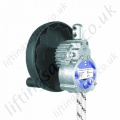


This aluminium housed controlled descent device with integral hoisting facility is a sturdy, low maintenance device fitted with a 10mm kernmantle rope lifeline, terminated with aluminium double action hooks at both ends. The attachment anchorage point on the controlled descent device is a cast swivel eye ø16mm, suitable for connection via a Standard Karabiner type connector, or a Standard Karabiner type connector with an Anchorage Sling.
This controlled descent device has an automatic speed regulator. The brake keeps the speed of the device constant during the descent.
The controlled descent device is designed and tested for single person use.
Specification
- Descent Rate: 0.9m/sec
- Dimensions: 200 x 200 x 120 mm.
- Device Weight: 1.9kg
- Rope Weight: 0.7kg/m
- Model Number: ABS3W20 (20m) ABS3W10 (10m)
Please Note:
This controlled descent device is CE marked against EN341 under the PPE Directive and should be treated as such and NOT as lifting equipment.
Safety Instructions for Use
- Non-observation of the instructions for use can endanger life! The abseil device must not be altered or added to in any way.
- The device is only approved for rescuing people. The maximum load for a rescue is one person. Safety authority regulations 198 and 199 must be observed.
- The legibility of the product designation should be checked before each use. A visual and function check of the type ABS 3/3H abseil device must be performed. For this the device should be attached to a suitable location and the protruding ropes pulled alternately. A noticeable brake resistance must develop. Check the spring clips for faultless function (self- closing, lockable).
- The abseil rope should be checked for perfect condition along its entire length and full circumference. A device with a damaged cable must not be used.
- If there are doubts as to the safe condition of the device it should be taken out of service and made available for testing by a specialist, trained by the manufacturer. The specialist decides on further use.
- The device must never be opened or repaired without authority. This may only be done by specialists who have been suitably trained by the manufacturer (point 6).
- The device may only be used by persons who have been appropriately trained and who are confident in the use of the device. They must not suffer from any health impairments! (problems with alcohol, drugs or the influence of medicines, or cardiovascular problems)
- A suitably sustainable attachment location should be selected for the device. if is fixed by means of spring clips. The spring clip locking device must always be closed to prevent accidental opening. The attachment location must be able to withstand a load of 10 kN to DIN EN 795. Attach the device as vertically as possible above the user.
- If an attachment location on an existing structure is selected this must be able to withstand a load of at least 7.5 kN.
- Attach the rescue loops of the casualty's belt to the abseil rope with spring clips. Only safety belts to DIN EN 361 or rescue belts to DIN EN 1497 may be used. The belt instructions for use should be followed.
- Raise the casualty with the lifting function until the fall protection system is relieved of their weight. Fold out the hand wheel crank handle, switch the non-return mechanism to Lift by means of the switching pin. The nominal lifting load is 100 kg, the minimum load 30 kg, the maximum lifting height 75m.
- Detach the accident victim from the fall protection system and begin the abseiling process as follows: pull the hand crank handle and fold it away. Turn the hand wheel in the Lift direction until the non-return mechanism carries no load. Hold the hand wheel. Press the switching pin towards Free running. Now slowly commence the abseiling process. The device can be additionally braked by either applying a hand to the hand wheel or by holding the upwardly moving rope. The abseil route must be free of obstacles. The rope must not be allowed to become slack under any circumstances.
- The device can be used vertically, horizontally or at an angle. If the rope runs over sharp edges suitable edge protection must be used.
This aluminium housed controlled descent device with integral hoisting facility is a sturdy, low maintenance device fitted with a 10mm kernmantle rope lifeline, terminated with aluminium double action hooks at both ends. The attachment anchorage point on the controlled descent device is a cast swivel eye ø16mm, suitable for connection via a Standard Karabiner type connector, or a Standard Karabiner type connector with an Anchorage Sling.
This controlled descent device has an automatic speed regulator. The brake keeps the speed of the device constant during the descent.
The controlled descent device is designed and tested for single person use.
Specification
- Descent Rate: 0.9m/sec
- Dimensions: 200 x 200 x 120 mm.
- Device Weight: 1.9kg
- Rope Weight: 0.7kg/m
- Model Number: ABS3W20 (20m) ABS3W10 (10m)
Please Note:
This controlled descent device is CE marked against EN341 under the PPE Directive and should be treated as such and NOT as lifting equipment.
Safety Instructions for Use
- Non-observation of the instructions for use can endanger life! The abseil device must not be altered or added to in any way.
- The device is only approved for rescuing people. The maximum load for a rescue is one person. Safety authority regulations 198 and 199 must be observed.
- The legibility of the product designation should be checked before each use. A visual and function check of the type ABS 3/3H abseil device must be performed. For this the device should be attached to a suitable location and the protruding ropes pulled alternately. A noticeable brake resistance must develop. Check the spring clips for faultless function (self- closing, lockable).
- The abseil rope should be checked for perfect condition along its entire length and full circumference. A device with a damaged cable must not be used.
- If there are doubts as to the safe condition of the device it should be taken out of service and made available for testing by a specialist, trained by the manufacturer. The specialist decides on further use.
- The device must never be opened or repaired without authority. This may only be done by specialists who have been suitably trained by the manufacturer (point 6).
- The device may only be used by persons who have been appropriately trained and who are confident in the use of the device. They must not suffer from any health impairments! (problems with alcohol, drugs or the influence of medicines, or cardiovascular problems)
- A suitably sustainable attachment location should be selected for the device. if is fixed by means of spring clips. The spring clip locking device must always be closed to prevent accidental opening. The attachment location must be able to withstand a load of 10 kN to DIN EN 795. Attach the device as vertically as possible above the user.
- If an attachment location on an existing structure is selected this must be able to withstand a load of at least 7.5 kN.
- Attach the rescue loops of the casualty's belt to the abseil rope with spring clips. Only safety belts to DIN EN 361 or rescue belts to DIN EN 1497 may be used. The belt instructions for use should be followed.
- Raise the casualty with the lifting function until the fall protection system is relieved of their weight. Fold out the hand wheel crank handle, switch the non-return mechanism to Lift by means of the switching pin. The nominal lifting load is 100 kg, the minimum load 30 kg, the maximum lifting height 75m.
- Detach the accident victim from the fall protection system and begin the abseiling process as follows: pull the hand crank handle and fold it away. Turn the hand wheel in the Lift direction until the non-return mechanism carries no load. Hold the hand wheel. Press the switching pin towards Free running. Now slowly commence the abseiling process. The device can be additionally braked by either applying a hand to the hand wheel or by holding the upwardly moving rope. The abseil route must be free of obstacles. The rope must not be allowed to become slack under any circumstances.
- The device can be used vertically, horizontally or at an angle. If the rope runs over sharp edges suitable edge protection must be used.
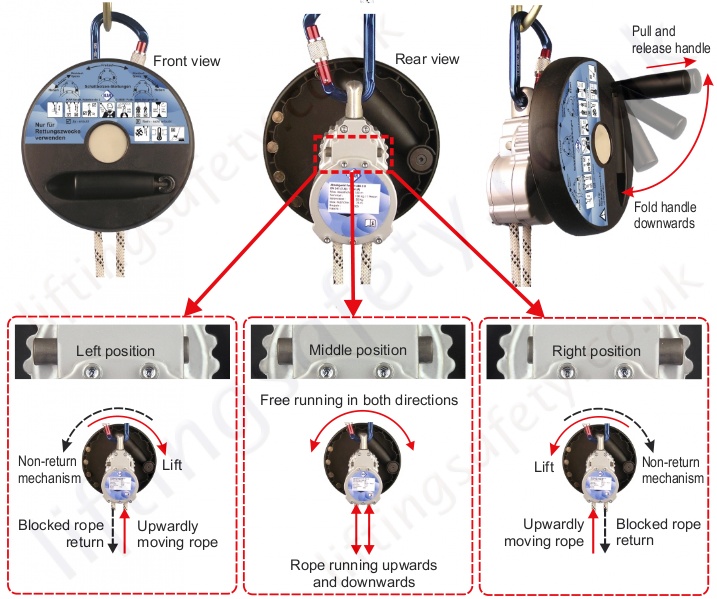
Pricing
Products of Possible Interest
Contact Us About This Product
If you wish to receive a quote for this product, please use the 'Pricing' tab above, this form is for general enquiries regarding this product only.
You can also Request a Quote using the Buy/Quote tab above!
You can easily add more than one item to the Quote Request. This is highly recommend as we will be able to suit your needs much more efficiently.
Share this page!

Save this QR code
for use on Smart Phones






